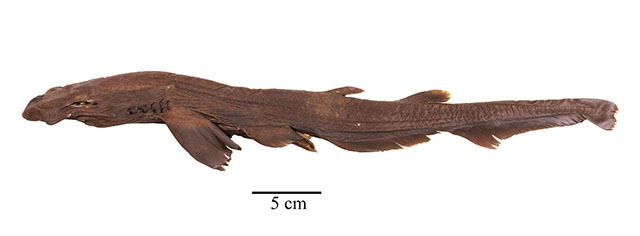| Pentanchidae (Deepwater catsharks) |
| 48.5 cm TL (male/unsexed) |
|
pelagic-oceanic; marine; depth range 1000 - 1120 m |
| Western Indian Ocean: Gulf of Aden, off Socotra Islands. |
|
This species of the ‘brunneus group’ of Apristurus is distinguished by the following characters: upper labial furrows distinctly longer than lower ones; first dorsal fin much smaller than second dorsal fin, originating distinctly posterior to level of pelvic-fin insertion; second dorsal-fin insertion clearly anterior to level of anal-fin insertion; snout moderately long, with pointed tip; pre-outer nostril length slightly greater than internarial width, about 0.6-0.8 times interorbital width; very short abdomen; pectoral-pelvic space much shorter than anal-fin base length; pectoral-fin tip posterior to level of midpoint of pectoral-pelvic space; spiral valves 17-19; monospondylous 33-36 and precaudal diplospondylous vertebrae 34-38; dermal denticles small giving a velvety texture to body surface; no enlarged dermal denticles along dorsal margin of caudal fin; claspers without hooks, posterior margin of exorhipidion forming a free lobe; colour of body and fins uniformly medium or dark brown (Ref. 97621). |
| Maximum size of females is unknown. Smallest paratype (33.7 cm TL) with short and soft claspers of 2.5% TL, ranked as immature (maturity stage 1); while holotype and other paratypes (43.2-47.7 cm TL) with long, fully developed claspers (5.8-8.1% TL), ranked as mature (maturity stage 3) (Ref. 97621). |
|
Least Concern (LC); Date assessed: 08 February 2017 Ref. (130435)
|
| harmless |
Source and more info: www.fishbase.org. For personal, classroom, and other internal use only. Not for publication.

